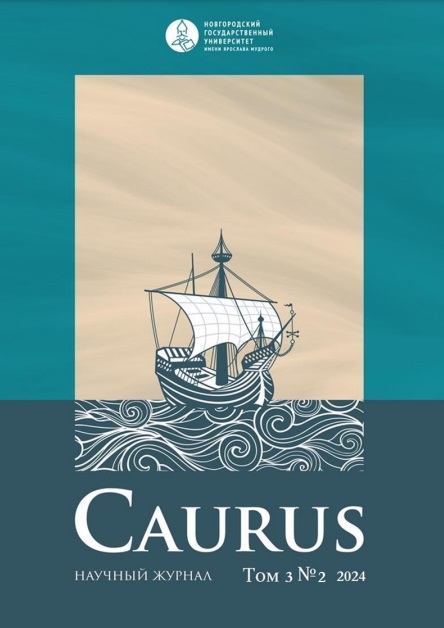From Editor-in-Chief
Abstract
Dear readers!
We bring to your attention the second issue of the third volume of the “Caurus” scientific journal. Most of it consists of the results of current research announced during the breakout sessions of the International Scientific and Practical Conference “IV Baltic Historical Readings. Disagreements and conflicts in the Baltic Communication Space in the Middle Ages and Modern Times”. The publication of the conference materials is expected to continue in subsequent issues of the journal.
The issue opens with an article by Yu. V. Kolpakova (Pskov), which presents an analysis of handwritten and folklore sources containing texts of conspiracies that could influence the decisions of official authorities, primarily the judiciary. The author identified the mechanisms used to influence the authorities, recorded rituals that complement conspiracies and also determined the circle of recipients to whom the magical influence was supposed to be extended. According to the researcher, the use of such conspiracies based on the magic of similarity was kind of an expression of protest of the broad masses of population, not ready for open rebellion, against the arbitrariness of the current authorities, whether they are judges, other royal officials or the sovereign himself.
The article by L. I. Ivonina (Smolensk) is devoted to the complex issues of two large-scale wars of the early 18th century – the Northern War and the War of the Spanish Succession, which in the period considered by the author (1704–1705) could have united into one pan-European war. The study focuses on Poland during the period of state crisis caused by dual power and the split within the political elites. At the same time, special attention is paid to Prussia’s attitude towards the Polish issue, since the Prussian king Frederick I was directly influenced by the Swedish monarch Charles XII, trying to win him over to his side of the conflict, but at the same time Prussia was bound by certain obligations in terms of the War of the Spanish Succession and violation of these obligations, as well as the active Polish policy of Peter I, could lead to irreversible consequences for the whole Europe. In his article, the author covered in detail all diplomatic contradictions in the context of the political and military events under consideration, as well as ways to resolve them.
The article by Yu. A. Kozlova (Bronnitsa) is devoted to the analysis of diplomatic ways to end the Northern War in 1713–1717 amid the crisis of the Westphalian system of international relations. During the period under review, the Russian government tried to find mediators in the person of European monarchs who could act as mediators in a large-scale conflict between Russia and Sweden, as well as lead the parties to a resolution of the conflict. The author consistently presented the course and specifics of diplomatic relations between Russia and Prussia and Great Britain, which had their own interests in the Baltic. The results of this negotiation process largely determined the unexpected reorientation of Russian diplomacy towards France, since the French government was to a certain extent interested in changing the hegemon of Baltic politics from Sweden to Russia.
The article by E. L. Nazarova (Moscow) analyzes references to the Battle on the Ice in Latvian periodicals of the late 19th – early 21st centuries. While researching the Latvian press, the author discovered a remarkable correlation: the perception of the Battle of Lake Peipus in the Latvian press directly depended on the sovereign status of the Baltic state itself in various periods of its history, since Latvia’s presence as part of the Russian Empire and later as part of the Soviet Union had a direct impact on how the Battle on the Ice was reflected on the pages of Latvian periodicals, in comparison with the discourse characteristic of independent Latvia or post-war Latvian emigration. The researcher draws attention to the fact that for the authors of articles in periodicals, the historical accuracy of the events described was not particularly important, since the Battle on the Ice for them is not so much a historical event as a symbol from the distant past through which it was possible to reflect the socio-political trends of the present.
The section with sources contains an article by A. V. Ushakov (Veliky Novgorod), which reflects the results of the researcher’s search work to identify documents containing information about the entrepreneurial activities of two Lübeck merchant corporations, namely the Nowgorodfahrer and the Revalfahrer, in a collection of letters from the city council of Lübeck to the magistrate in Reval from the early 16th century, stored in the Tallinn City Archives. Some of the identified documents relate to the history of litigation between Hanseatic merchants, other sources should be considered in the context of Hanseatic-Danish-Swedish contradictions on the eve of the war of 1510–1512. Full transcriptions of the five identified documents are placed by the author in the Appendix to this article and are provided with annotations in Russian, as well as the necessary comments.
Dear readers, we hasten to inform you that since 2024, the editorial board of the “Caurus” journal has changed the frequency of issues. Focusing on the requirements of the Higher Attestation Commission, the “Caurus” journal shifts to four issues per year. As before, all readers will be provided with free access to the full texts of all published materials on the official website of the online periodical.
M. B. Bessudnova







